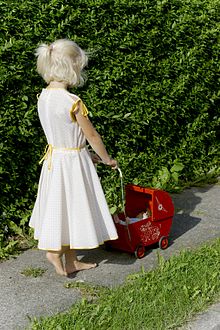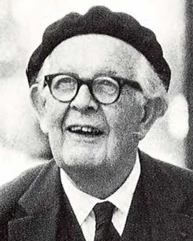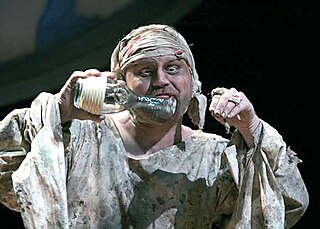Components
Role-play

When children participate in social role enactment, or role-play, they are portraying the identity or certain traits of another individual. [1] This includes representing both external and internal qualities. [2] When a child role-plays alongside one or more other individuals, they are engaging in an activity called sociodramatic play. Sociodramatic play emerges at around three years, and sometimes earlier for children who have older siblings. During its early stage, it follows a very strict script, sticks closely to existing roles and includes more parallel play than interactive play. By the age of 5, children begin to deviate from the strict roles and scripts. They start to integrate more imagination into their roles and build off of their partner's creations. [2]
Role play exists in three forms. Relational role-play, usually the first to emerge, is based on relationships that the child observes or experiences. Such relationships include mother and child, father and child, husband and wife, etc. Functional role-play emphasizes on the jobs and actions that the character usually performs. Character role play portrays the character's stereotypical features usually determined by society's representation of them. [2]
Pretend play allows for children in low socio-economic backgrounds not to miss out on important developmental milestones, as all a child needs to pretend is their own imagination. Skills that would otherwise require being fostered by educational toys may be developed through pretend play since it is not limited by the child's financial background.
Complex forms of role-play involve the ability of the child to represent another individual's mental representation. This skill appears when a child is around 5 years of age. This strengthens the child's social ability by allowing him/her to take another individual's perspective and can therefore understand and cooperate with others. [2]
Nonliteral actions
Five recurring behaviors in pretend play that indicate its nonliteral aspect will be explained. The first behavior is the tendency of performing a task without the presence of a necessary instrument, such as pretending to make a call without using an actual phone. The second behavior is substitution, in that the child might use a block rather than a telephone to make a phone call. The third behavior, discussed in the section above, is when a child takes the role of another individual and performs their usual actions, such as pretending to be a firefighter and extinguishing a fire. The fourth behavior is when a certain action results in an unrealistic outcome, such as a child pretending to clean the room by simply snapping a finger. The fifth behavior will be discussed in depth in the following section and it involves giving an inanimate object, such as a doll, animate qualities, such as talking and drinking tea. [1]
It is important for a child to always understand that pretense is isolated from the real world. This means that the child must understand the nonliteral aspect of pretend play and understand that the changes made during pretend play are temporary. Children must be aware that once the play session ends, the nonliteral aspects of pretend play such as role taking and substituted objects also cease to exist. [4] One form of pretend play widely observed in children is the creation of imaginary companions. Imaginary companions can be entirely in the child's imagination or they can be based on a doll or stuffed toy that portrays animate qualities. About one to two-thirds of children under 7 years of age have an imaginary companion that later diminishes as the child ages. [4] The significance of this form of pretend play has not yet been determined; however, there have been some speculations[ by whom? ] that it supports children's fledgling social skills.
Toys and props
In a study by Welsch, children provided with props showed sophisticated levels of play. [5] In pretend play, any object in the child's surroundings can be used as a prop.
Substitution
Any object can be integrated into pretend play as a representation of another object. This kind of representation is referred to as substitution. The ability to substitute one object for another emerges when a child is about 2 years old. [2] In early instances of substitution, children are only capable of substituting objects that either have a similar structure or a similar function. [2] For example, a child can pretend that a pen is a toothbrush, or that a television remote is a telephone. A pen has roughly the same shape as a toothbrush, while the remote has buttons that function similarly to a telephone. Around the age of 3, the child begins to master substitution and no longer needs physical or functional similarity between the actual object and the substitute. [2] The child also becomes capable of substitution without the use of a concrete object, thus depending solely on imagination [4] (e.g. putting their palm to their ear and having a conversation, indicating a phone call). The ability to hold more than one substitution at a time also increases, meaning that the child can pretend to be on the phone, walking a dog, and sipping juice all at once. [2]
There are two types of substitutions. Symbolic substitution is when one object is used to represent another, such as when a coach uses sticks to represent players in a game plan. Hypothetical substitution is when one object is used "as-if" it actually is another object, such as the previous example of imagining that a pen functions as a toothbrush. [2]
Doll play

Pretense with dolls begins when a child extends pretend self actions to a doll. A child might start by pretending to feed themselves, then reach out and pretend to be feeding a doll. This is further developed when a child begins giving the doll an active role rather than a passive one. [1] For example, the doll does not just eat when fed by the child, instead, the child pretends that the doll reaches for the spoon and feeds itself. After the doll is given an active role, the child begins to bestow upon it sensory and emotional attributes, such as feeling sad, happy, or hurt. [2] The highest form of doll play appears when a child is about 3 and a half years of age. At this point, the child is capable of giving the doll cognitive abilities. [2]
A distinguishing feature between doll play and social play, which includes more than one child, is the degree of control a child has. When participating in doll play, the child has full control over the situation. [2]








